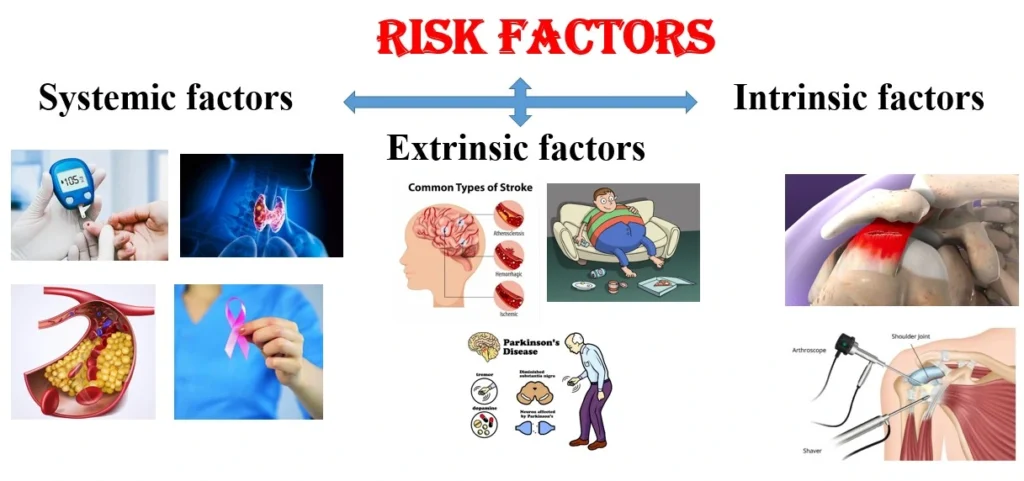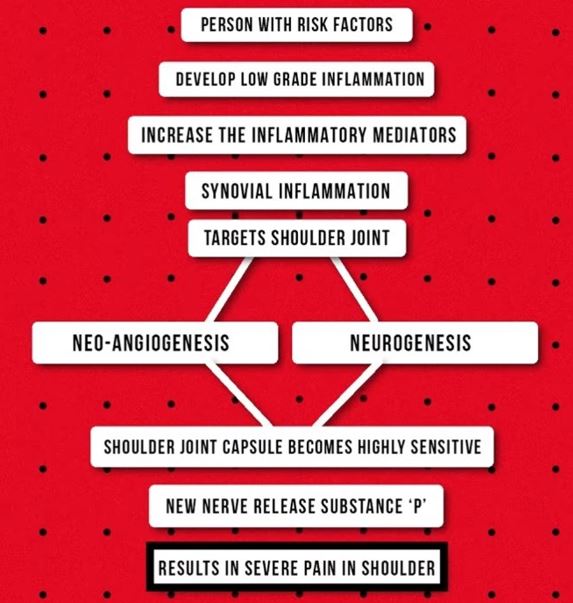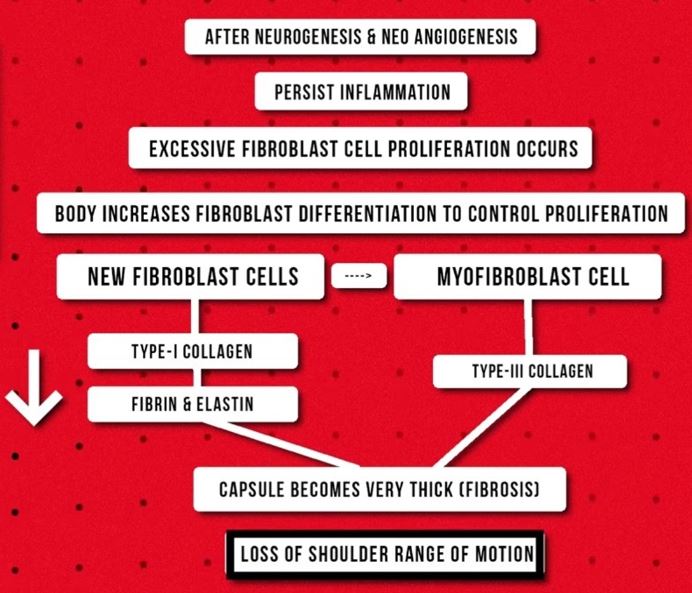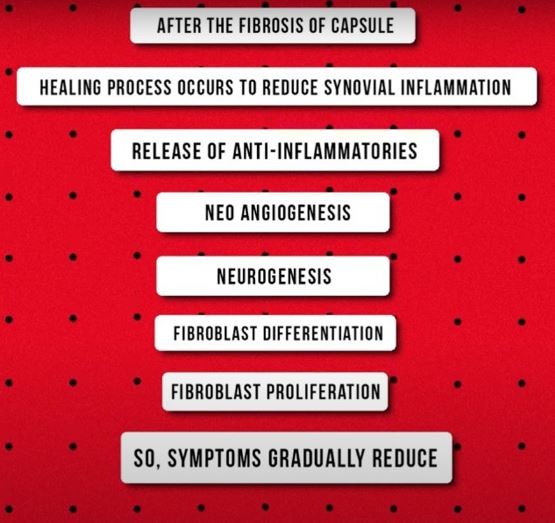Contents
- 1 FROZEN SHOULDER
- 1.1 WHAT IS FROZEN SHOULDER?
- 1.2 WHO’S AT RISK FOR FROZEN SHOULDER
- 1.3 STAGES OF FROZEN SHOULDER
- 1.4 WHAT ARE THE SYMPTOMS OF FROZEN SHOULDER?
- 1.5 HOW FROZEN SHOULDER SHOULD BE DIAGNOSED?:
- 1.6 DIFFERENTIAL DIAGNOSIS
- 1.7 OUR BEST TREATMENT APPROACHES FOR FROZEN SHOULDER
- 1.8 CAN FROZEN SHOULDER BE CURED?
- 1.9 HOW LONG DOES THE FROZEN SHOULDER LAST?
- 1.10 IS IT OKAY TO MASSAGE?
- 1.11 WHAT FOODS ARE BAD FOR FROZEN SHOULDER?
FROZEN SHOULDER
WHAT IS FROZEN SHOULDER?
Frozen shoulder is an inflammatory disease characterised by synovial inflammation and fibrosis of the shoulder joint capsule manifesting severe pain and progressive loss of joint range of motion. Its also called Adhesive capsulitis, peri-arthritis shoulder, stiff shoulder and 50 year old shoulder syndrome.
PREVALENCE
Up to 5% of the global population has frozen shoulder. Females are four times more often affected than men and diabetic patients are more prone to developing this condition.
WHO’S AT RISK FOR FROZEN SHOULDER
The risk factors are classified into three categories SYSTEMIC, EXTRINSIC, and INTRINSIC. Middle and old age (40-60 years) people who have any of these risk factors can be affected by frozen shoulder.
Systemic factors refer to the factors which affect multiple systems of the body. Extrinsic factors refer to non-shoulder related factors and intrinsic refer to shoulder joint-related factors. Let’s see what they are.

SYSTEMIC FACTORS
- Diabetes
- Thyroidism
- Hyperlipidaemia
- Breast cancer
EXTRINSIC FACTORS
- Stroke
- Parkinsonism
- Sedentary lifestyle
INTRINSIC FACTORS
- Repeated shoulder injuries/ Shoulder surgeries
STAGES OF FROZEN SHOULDER
The 3 stages of frozen shoulder are Freezing, Frozen, and Thawing
FREEZING STAGE
- synovial inflammation
- shoulder pain
- 2 to 9 months
FROZEN STAGE
- fibrosis of joint capsule
- shoulder stiffness
- 4 to 12 months
THAWING STAGE
- spontaneous recovery
- 12 – 42 months
WHAT ARE THE SYMPTOMS OF FROZEN SHOULDER?
Freezing stage: Severe shoulder pain, especially in night because of inflammation, and gradual loss of shoulder joint range of motion.
Frozen stage: Pain will be less but the shoulder becomes stiff which leads to progressive loss of shoulder range, and difficulty in daily life activities.
Thawing stage: Less/no pain, shoulder range will gradually improve to full/near normal range.
PATHOPHYSIOLOGY OF FROZEN SHOULDER
WHY PAIN OCCURS IN 1ST STAGE?

HOW STIFFNESS OCCURS IN 2nd STAGE?

HOW SPONTANEOUS RESOLUTION OCCURS IN 3rd STAGE?

HOW FROZEN SHOULDER SHOULD BE DIAGNOSED?:
Frozen shoulder is a common shoulder pathology, but remember that every shoulder pain & shoulder stiffness is not a frozen shoulder. If a diabetic patient came with a complaints of shoulder pain & shoulder stiffness most of the health care professionals misdiagnose it as a frozen shoulder.
DON’T ASSUME THE DIAGNOSIS, INSTEAD ASSESS IT!
10 key features to accurately diagnose frozen shoulder
- Night pain
- Pain in overhead/ sudden shoulder movement
- Coracoid pain test is +ve
- No history of injury/overload
- Loss of both Active & passive range of motio (External rotation>abduction>flexion & internal rotation)
- 30% loss of shoulder movements in more than 2 planes
- 50% loss of external rotation
- Isometric contraction of shoulder – pain free (no pain)
- Normal shoulder X-ray
- Reduced cervical & thoracic mobility
DIFFERENTIAL DIAGNOSIS
Differential diagnosis is very important to avoid misdiagnosis, which is the most common error in the medical field. Let’s see how to differentiate frozen shoulder from other shoulder pathologies.
1) Acromio clavicular pathology – localised pain, shoulder joint ROM preserved, positive cross arm adduction test.
2) Biceps tendinopathy – tenderness over long head of biceps tendon & localised anteriorly, positive speed/ yergason test
3) Rotator cuff pain – passive ROM is preserved, history of overload/ injury
4) Subacromial & subdeltoid bursitis – passive ROM is preserved.
5) Autoimmune disease – multiple system/multiple joints involvement, positive rheumatoid factor test/antinuclear antibody test
6) Cervical disc pathology – upper limb numbness, weakness, limited neck ROM more & pain in active neck movements
7) Neoplasm – fever, chills, night sweats, unexplained weight loss
8) Shoulder osteoarthritis – older age, history of shoulder trauma/surgery degenerative changes in x-ray
WHAT ARE THE POSSIBLE TREATMENTS FOR FROZEN SHOULDER?
Despite the number of published literature on the frozen shoulder, there is no consistent consensus about management of AC. The majority of treatment options are non-operative which includes pharmacological management and Physical therapy. Operative treatment (capsular release & manipulation under anaesthesia) is also there but its in-effective compare with Non operative treatments.
PHARMACOLOGICAL TREATMENT
Ziradkar R, concluded in the systematic review & meta-analysis that Non-steroidal anti-inflammatory or corticosteroid injections/drugs are beneficial for pain relief and improving function but only for a short term, there is no long term results.
PHYSIOTHERAPY TREATMENT
In physiotherapy, there are lots of treatment approaches like joint mobilization, assisted/active strengthening exercises, shoulder & thoracic mobility exercises, electrotherapy modalities, muscle releasing and etc,. But there is no one best treatment for frozen shoulder. So you can give any physiotherapy treatment approaches that might help them. But vigorous passive movements/ joint mobilizations are highly contraindicated which increases their pain sensitivity.
Challoumas D concluded in his systematic review and meta-analysis that Physiotherapy would be highly beneficial for frozen shoulder patients who are in 2nd stage(frozen stage)
OUR BEST TREATMENT APPROACHES FOR FROZEN SHOULDER
Best treatment approach starts with a proper assessment of a patient (not just in the assessment of the condition)
OUR ASSESSMENT
- History collection
- Accurately Diagnose the condition with clinical co-relation
- Assessment for fear of movement
- Psycho-social factor assessment
- Identify the root cause/risk factors for having frozen shoulder
HOW TO APPROACH A PATIENT
- Explaining the condition in a simple way as stiff shoulder
- Don’t use fancy diagnostic terms (capsulitis/fibrosis)
- Spread positivity
- Explain the entire rehab process
- Educate about pain
HOW TO PLAN A TREATMENT PROGRAM
- Treatment should focus on the root cause
- Address the psycho-social part
- Reduce the session frequency because it’s not going to resolve quickly
- Treat the shoulder – work on improving the shoulder mobility & strength with active approaches
- Provide Home exercise programs that focus mainly on improving overall physical & mental health. Don’t focus only on the shoulder.
CAN FROZEN SHOULDER BE CURED?
Yes. It will be cured because it’s a self resolving condition. We can speed up this recovery process by proper physiotherapy treatments. But it won’t be cured immediately like few months. Once the shoulder stiffness developed It takes more than 6 months to be cure completely but it will vary from patient to patient.
HOW LONG DOES THE FROZEN SHOULDER LAST?
Frozen shoulder will last for 12 – 42 months. But it highly varies from patient to patient. That’s why speeding up the recovery as much as possible is the main role of a physiotherapist
IS IT OKAY TO MASSAGE?
Yes. But massaging / releasing muscles are passive approaches. So it will be only helpful temporarily for a short period of time.
WHAT FOODS ARE BAD FOR FROZEN SHOULDER?
High fat & glucose rich products needs to be avoided. It will be better to take protein, fiber & anti-oxidents rich foods which will helps to reduce the inflammation.